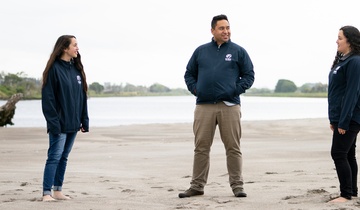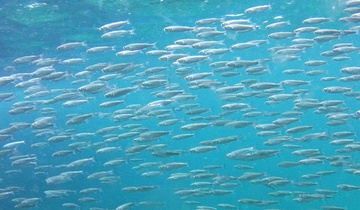On a global scale, market demand for eels as a foodstuff is high and declines in wild eel production mean that aquaculture is being put forward as a potential eel source. Worldwide production of eels is estimated to be worth over $US 1 billion annually, with 233,589 tonnes of eel produced each year. All eel farming is currently dependent on wild-caught glass eels.
The two main species involved in aquaculture are the European eel (A. anguilla) and the Japanese eel (A. japonica). The Japanese eel is preferred by the Asian market and therefore the cost per kilo for these glass eels tends to be higher than for European eels. Asian production is centred in Japan, Taiwan and China with the premium product originating from Japan and Taiwan. Recent reports of glass eel shortfalls for large Asian eel producers underscore the current worldwide decline in wild eel numbers. This shortfall has renewed interest in other species such as the shortfin eel, A. australis.
There is an on-going body of work (both internationally and in New Zealand) to investigate captive spawning of eels. Limited technical successes have been reported in Japan and Europe. Some of these technical successes have been repeated in New Zealand by the Mahurangi Technical Institute using A. australis. Although the artificial induction of eel maturation and raising the larvae through to the glass eel stage have been achieved in several places, the breeding of eels in captivity is not currently economically viable.
Within the farm situation, there are various established systems used for eel aquaculture. Pond culture, accelerated temperature facilities and recirculation systems are the most common types of facility. Recirculation systems require more maintenance but require less water to operate than the other systems and can provide year-round controlled conditions. As eel activity is regulated by water temperature, it is important to keep water temperatures as constant as possible. Water temperatures in culture systems for most Anguillid eel species typically range from 22 to 28°C in order to maximise growth. Wild caught eels can be weaned onto formulated diets with relative ease if the process is initiated before the eels become pigmented (i.e., as glass eels). While some live feed (like brine shrimp) are used, fish are established on formulated diets within a fortnight.
At present, eel aquaculture is largely based in Asia and the once-prolific eel farms in Europe are mostly gone. A more recent foray in Australia into the industry soon found that it was more profitable to sell seed stock to Asian farms than to grow locally. The prospect of Australia harvesting large quantities of glass eels for aquaculture purposes, as has occurred in Asia, Europe, North America, and the subsequent disastrous effect this has had on natural stocks and subsequent recruitment on these continents has potential implications for the New Zealand eel populations of shortfin and Australian longfin eels. In view of what has occurred on other continents, it was certainly wise of New Zealand authorities to have introduced a minimum harvest size of 150 g in 1981 (220 g since 1992).
However, there is political pressure to change these regulations as the economic gains from harvesting of glass eels for export is potentially significant, albeit for the short term gain. Limiting the collection of juvenile eels from the wild, as has also been implemented in Europe and North America, can pressure the aquaculture industry to provide the necessary funds to accelerate the process of producing glass eels to supply to the farms. Indeed, although there is much still to learn, a breakthrough in captive breeding would certainly give wild stocks a reprieve.
References and further reading
FAO (2011). www.fao.org/fishery/culturedspecies/Anguilla_anguilla/
Ingram, B.A., Gooley, G.J., De Silva, S.S., Larkin, B.J., Collins, R.A. (2001). Preliminary observations on the tank and pond culture of the Australian eel, Anguilla australis Richardson. Aquaculture Research 32: 833-848.
Kagawa, H., Tanaka, H., Ohta, H., Unuma, T., Nomura, K. (2005). The first success of glass eel production in the world: Basic biology on fish reproduction advances new applied technology in aquaculture. Fish Physiology and Biochemistry 31(2-3): 193-199. http://www.springerlink.com/content/u234158l51587447/
Li, X., Li, J., Wang, Y., Fu, L., Fu, Y., Li, B., Jiao, B. (2011). Aquaculture Industry in China: Current State, Challenges, and Outlook. Reviews in Fisheries Science 19(3): 187-200. http://www.tandfonline.com/doi/abs/10.1080/10641262.2011.573597
Skehan, B.W., Silva, S.S.D. (1998). Aspects of the culture-based fishery of the shortfinned eel, Anguilla australis, in western Victoria, Australia. Journal of Applied Ichthyology 14(1-2): 23-30. http://onlinelibrary.wiley.com/doi/10.1111/j.1439-0426.1998.tb00609.x/abstract
Tanaka H, Kagawa H, Ohta, H. (2001). Production of leptocephali of Japanese eel (Anguilla japonica) in captivity. Aquaculture 201: 51-60. http://www.sciencedirect.com/science/article/pii/S0044848601005531
Tanaka, H, Kagawa, H., Ohta, H., Unuma, T., Nomura1, K. (2003). The first production of glass eel in captivity: fish reproductive physiology facilitates great progress in aquaculture. Fish Physiology and Biochemistry 28: 493-497. http://www.springerlink.com/content/u7k53n3k6275v518/






